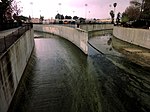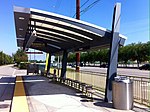Warner Center station

Warner Center station is an intercity bus station and former bus rapid transit station in the eponymous commercial development in the Woodland Hills neighborhood of the San Fernando Valley in Los Angeles, California, United States. When service began on the Orange Line (now the G Line) in 2005, Warner Center was the western terminus, and the only stop not on the dedicated busway. In 2012 an extension of the Orange Line opened to Chatsworth station, leaving Warner Center on a one-stop stub served by alternate buses. Service to Warner Center station on the Orange Line ended on June 24, 2018, replaced by a shuttle that stopped in several locations around the Warner Center area before offering passengers a transfer to the Orange Line at Canoga station, running every 10 minutes.The station remains standing as a transit hub for the area and is now served by several other bus lines.
Excerpt from the Wikipedia article Warner Center station (License: CC BY-SA 3.0, Authors, Images).Warner Center station
Oxnard Street, Los Angeles Warner Center
Geographical coordinates (GPS) Address Nearby Places Show on map
Geographical coordinates (GPS)
| Latitude | Longitude |
|---|---|
| N 34.1804 ° | E -118.6014 ° |
Address
Oxnard Street
91367 Los Angeles, Warner Center
California, United States
Open on Google Maps









